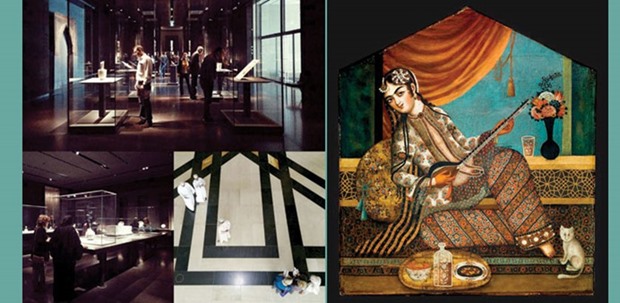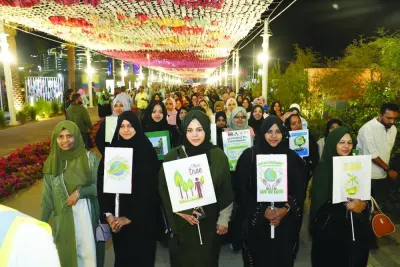A new lunchtime series of lectures at the Museum of Islamic Art (MIA) seems to be just the right dose of insight into culture and tradition that Doha had been missing. What better way than flagging off the series with an inaugural lecture that opens the doors to the fascinating world of Islamic Art, focusing on the key designs and dynasties?
Dr Mounia Chekhab-Abudaya, Curator for North Africa & Iberia, will throw light on major facets of the subject in her lecture Introduction to Islamic Art, tomorrow, from 11.30am to 12.30pm, at the MIA Auditorium. “Informative but fun, these lectures are designed with the general but enthusiastic visitor in mind,” says a note on the MIA’s Facebook page on their new series.
The Curator of Manuscripts at the Museum of Islamic Art, Chekhab-Abudaya completed her PhD in Islamic Art History and Archaeology at the Pantheon Sorbonne University in Paris, with a specialisation in Maghreb and the Sahara regions. With a great interest in languages, Chekhab-Abudaya holds a degree in Literal Arabic from the National Institute of Oriental Languages and Civilisations (INALCO). She studied Persian and Turkish respectively at INALCO and the Ecole Normale Supérieure of Paris.
Not only has she taught Islamic Art at BA and MA levels for four years at the Pantheon Sorbonne and INALCO, she has also helped at the Department of Islamic Art at the Louvre Museum in Paris for the preparation of the new display which opened in September 2012.
At MIA, Chekhab-Abudaya has curated Hajj – The Journey through Art (2013 - 2014) in collaboration with the British Museum, which explored the history of the sacred pilgrimage through the centuries, “focusing on the routes taken by pilgrims, the rituals of Haj as depicted through art, the experiences of pilgrims after completion of Haj,” and also included a special section dedicated to the oral histories and objects of Qatari pilgrims.
Meanwhile, Qajar Women: Images of Women in 19th-Century Iran, which, too, happens to be co-curated by Chekhab-Abudaya, continues to draw visitors at the Museum as it is set to run until June 11. The exhibition, MIA says, demonstrates the centrality of women in the artistic expression of 19th-century Iran and how it continues to inspire contemporary artists.
“The most popular representations of the Qajar era have been of male sovereigns, whose life-size portraits exaggerate masculinity to depict power. Yet, this era also saw a period of artistic modernisation in Iran, particularly in paintings and photography, in which depictions of women became essential elements of the scenes. Showcasing women at the court, and in private, alongside images of female musicians and aristocratic women, this exhibition explores rarely-told narratives of the Qajar artistic tradition,” a note on the exhibition says.
The Qajar dynasty in Iran, which spanned 130 years, began with Agha Mohammad Khan Qajar in 1795 and ended with Ahmad Shah in 1925. The period saw considerable British and Russian regional influences that eventually created a backlash over time in the form of the Constitutional Revolution. In the 19th century, under the Qajars, Iran lost much of its territory in the Caucasus and Central Asia to Russia.
The Qajars were a Turkmen tribe that held ancestral lands in present-day Azerbaijan. The Qajar shahs relied heavily on the visual arts to solidify their new position. One aspect of their public image tied them to the long history of Persia and its ancient dynasties, but another component of their identity was as modernisers and reformers who ushered in the foreign influence on Iran.
“Through a variety of historical objects from MIA’s collection, in juxtaposition with photographs and contemporary artworks inspired by the Qajar period, we explore the meaning of the image of women at the onset of modernity,” the note says.
Meanwhile, MIA happens to have recorded a footfall of 344,934 visitors in 2015, making it the most visited year since the museum opened. “Of those visitors, 17,400 were school children. Our 2015 exhibitions, Marvellous Creatures had 83,000 visitors and The Hunt had 69,000 visitors,” says a note by the MIA. This year, the Museum says it’s keen to extend its open arms to both local and international visitors, including our GCC neighbours, to the traditional riches that abound in its sprawling structure.

CROWDPULLER: MIA recorded a footfall of 344,934 visitors in 2015, making it the most visited year since the museum opened. Right: Qajar Women: Images of Women in 19th-Century Iran, which, too, happens to be co-curated by Chekhab-Abudaya, continues to draw visitors at the Museum.


